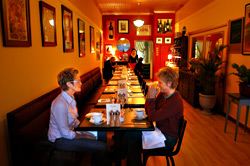Warning: The Weekly learned on October 30, 2006, that Bistro Mazaran’s owner had closed the restaurant. As of November 18, 2006, it appears to be reopened. We recommend calling for more info.
It was almost too studied: The menu at Bistro Mazaran only listed a dozen French dishes, each a classic of the Julia Child era. The soundtrack was heavy on the accordions. And the room was decorated with Toulouse-Lautrec prints and a miniature Eiffel Tower. When our waitress arrived at our table, her accent elegant and Turkish, I wondered: How much of this Frenchitude was faked?
“I have to tell you a few things about the menu,” she said. “We don’t have the spinach salad.” She paused to shrug: C’est la vie, what can one do? “We don’t have the leeks in vinaigrette. Or the onion soup. You’ll see the chicken made two ways, sautéed and roasted, but we only do one at a time, so today is roasted. And on the wine list, we’re out of the Côtes de Rhône.”
Definitely real French.
Bistro Mazaran is just one of two new French restaurants—Saint Germain is the other—to open this fall in the neighborhoods just west of Lake Washington. Neither explores the nooks and crannies of traditional bistro cuisine. But there’s something about their appealing hominess, and the wry welcome they offer, that is even more authentic than the bold- lettered Gallicism of their decors.
Bistro Mazaran’s French chef and owner, Nohra Jacobs opened the bistro six weeks ago, and has been quietly recruiting window-peekers walking down 34th Avenue. Mao-red at the back and marigold along the sides, the wee room—there’s just enough space for one closely spaced row of tables—is crowned with a gorgeous tin ceiling painted copper. You’re bathed in warm hues, and come January, a meal at Mazaran may feel more therapeutic than a light box.
Its food is simple to the nth: Butter lettuce tossed with a three-parts-oil, one-part-vinegar dressing ($7). A quarter of a roast chicken, marinated in lemon and herbs, served with a square of creamy potato gratin and a small heap of roasted vegetables ($15). A fresh-baked apple tart ($8)—thinly sliced fruit suspended in the lightest of custards. Apart from a newfangled beet Napoleon ($10), sliced and reassembled with herbed goat cheese between the layers, there’s nothing you haven’t seen before. Boeuf bourguignon ($18) hasn’t been exotic since 1934, but in Jacobs’ kitchen it’s well braised, the wine- and-stock sauce rich with mushrooms, bacon, and hours in the oven.
Both of the specials we tried came with the same potato gratin and the same mixed vegetables. Three pan-roasted rack-of-lamb chops ($22) were perfectly juicy, crusted with just the right amount of salt, and a filet of sole ($20), browned in butter, pulled apart at the slightest touch of the fork. They’re executed so well, they made me wish Jacobs would delve into less predictable dishes that reflected her Algerian-French heritage and south of France upbringing.
One more thing: When I returned for a second visit, not only was the kitchen out of the same dishes, it had dropped a few more, so I had to repeat my first meal. Evoking la vraie France is one thing; re-creating Paris in the midst of post-occupation rationing another. Instead of making diners look over all the dishes they can’t have, may I suggest a chalkboard?
I also puzzled over the dinner menu at Saint Germain: cheap, open-faced sandwiches and salads ($5.50 to $9), with a couple of heartier specials recited by the server. Dinner? Then I overheard owner Jean-Michel Omnès telling another table, “I wanted this place to be a wine bar, but people seem to want it to be a restaurant,” and suddenly Saint Germain made sense.
Omnès’ take on the bar à vins, in fact, has been gaining ground all over France. As the population drinks less and less wine, more and more bars have been adding sections where food is served, the Gallic equivalent of Britain’s gastropub.
Saint Germain is definitely an Americanized take on the phenomenon, with lighter, humbler fare in addition to a nicely parsed French-American wine list heavy on the half-bottles. The only dish that didn’t succeed was the one that tried the hardest: Lavender is a high-risk herb to add to a dish, either mind-blowing or ghastly, and when the cooks liberally added lavender to the vinaigrette on a salade niçoise ($9), it clashed with the black olives, anchovies, and meaty seared tuna. But the salade St. Germain ($6)—butter lettuce, little bits of apple, and shaved fennel in vinaigrette perfectly keyed to the ingredients’ mild sweetness—was lovely, and a tartine with sliced smoked duck breast and tangy goat cheese ($6.50) just the thing to counter a glass of cabernet. Made with Kobe beef, the hachis Parmentier ($13), a mountain of soft mashed potatoes with ground beef at the base and a slice of Gruyère broiled onto the summit, was the French equivalent of truffled mac ‘n’ cheese, and just as welcome.
The small, window-wrapped room is outfitted like a sailor, in dress blues and whites, with black-and-white photos of the St.-Germain-des-Prés neighborhood blown up to backdrop size so you can pretend you’re an extra in Breathless. Throughout the night, Omnès wanders around, cracking bilingual jokes to French- and English-speaking tables. He’s not an effuser but more of an enabler of good will.
What I enjoyed most about both of these places is that, despite their flaws and eccentricities, they emanate that French comfort with the life of the table: You don’t go to a destination like Bistro Mazaran or Saint Germain to eat destination food. You’re there to sip wine, eat leisurely, run out for a smoke, talk as long as it takes to finish the conversation. Where else would you want to be?






